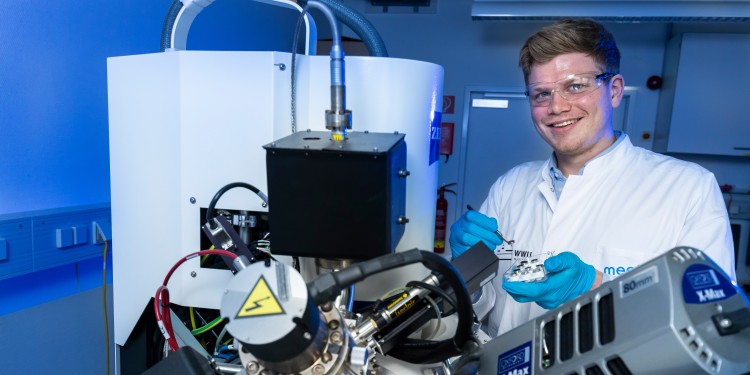
For a greener carbon footprint
The Federal Statistics Office has made an exact tally: in 2019, 83.7 million lithium-ion batteries were sold in Germany. The carbon footprint they create is currently significant, especially in their production. Because batteries play a key role in the successful implementation of the energy transformation – and in the associated increase in electromobility – the aim is for them to become “greener” in future. In an interdisciplinary joint project entitled “Green Electrochemical Energy Storage” (“GrEEn” for short), the MEET Battery Research Centre at the University of Münster – in collaboration with the University’s Faculty of Biology, the Jülich Research Centre’s Helmholtz Institute in Münster, and RWTH University in Aachen – is engaged on a research programme to develop a more sustainable lifecycle for batteries.
“Besides the key requirements for batteries – performance, safety, energy, lifetime and costs – our aim is to increase sustainability in the value chain,” explains Jens Matthies Wrogemann, the scientific coordinator of the “GrEEn” project and, since 2017, a PhD student at MEET. “To this end, we are concentrating on the development of battery storage technologies on the basis of more environmentally friendly materials for stationary and mobile applications. So far, production methods have often been too energy-intensive and resource-intensive.”
Lithium-ion batteries (LIBs) are currently the number one choice for portable electronic devices, electromobility or stationary energy storage. The global market for LIBs is large, with demand growing constantly. The idea of sustainability in battery production now plays an ever more important role – although one in which there is still room for improvement – and it is never seen separately from the question of costs. The best way to create more sustainable technological features in particular would be to look at materials different from those currently being used. LIBs are closed systems which consist of two electrodes: an anode (negative electrode) and a cathode (positive electrode). The anode and the cathode are separated by an electrolyte-soaked separator.
While transition metals such as cobalt or nickel are often used for the cathode, carbons such as graphite are used to store the lithium on the anode side. There are two basic types of graphite: natural graphite and synthetic graphite. The largest deposits of natural graphite are found in China, but mining and processing it result in a high level of water and air pollution. Moreover, monitoring is inadequate, as are measures to reduce environmental impacts. Energy consumption in the production of synthetic graphites is high. Also, the high proportion of critical and toxic metals in the positive electrode in LIBs likewise produces in today’s batteries an eco-balance with room for improvement. These materials – especially cobalt – have a high strategic value and are only available in limited quantities. For this reason, experts within the European Union classify these materials as “critical”.
One of the aims which researchers working on the “GrEEn” project have is to reduce the share of critical materials needed for battery production; another is to use renewable and sustainable raw materials from biomass and waste products. “We’re looking at what materials we can use from nature,” says Wrogemann. One example of processing organic resources is coffee grounds, from which synthetic graphite can be obtained for the anode. The researchers are not only looking for an environmentally friendly method for cleaning natural graphite, but are also trying to find a way to do without, or to substitute, toxic components such as organic solvents in electrode production. The aim in doing so is, step by step, to reduce the environmentally critical resources. A – from a CO2 point of view – more efficient production, in combination with more recycling of materials and components, can ultimately lead to a “greener” carbon footprint. “We’re carrying out basic research and are trying to demonstrate new possibilities of producing and, in the end, evaluating more sustainable batteries,” says Wrogemann. One difficulty is the large number of battery technologies needed specially. There is no universal solution for all applications.
The “GrEEn” project has been running since 2017 and is due to end in December 2021. It is being funded by the Economics Ministry of the State of North Rhine-Westphalia. The project is subdivided into several subprojects dealing with the development and analysis not only of biogenic active materials for electrodes, but also of electrolytes and alternative cell components. Economic and ecological aspects, which include for example the recyclability and ageing processes in batteries, are also being examined in the project.
“We’re also taking a look at the development of alternative battery systems because – from the point of view of energy density – LIBs are increasingly coming up against their physical and chemical limits,” says Wrogemann. “But many technologies are still in their infancy,” he adds. Not only manufacturers of materials and cells, but also battery users will benefit from the basic research being undertaken in the “GrEEn” project. Moreover, the sustainable and environmentally friendly approach being taken can also increase public acceptance of such batteries.
This article was first published in the University newspaper wissen|leben No. 2, 14 April 2021.
Author: Kathrin Nolte
